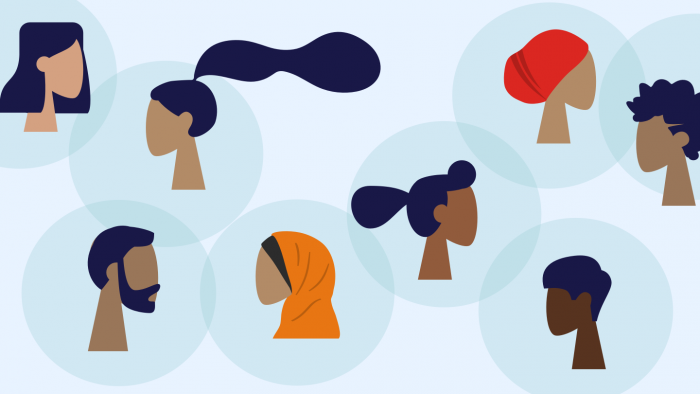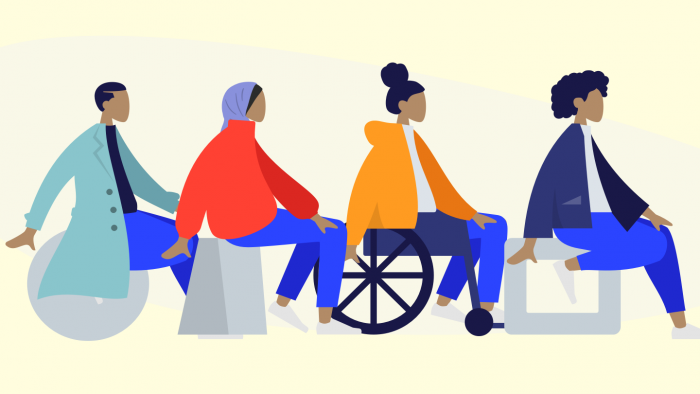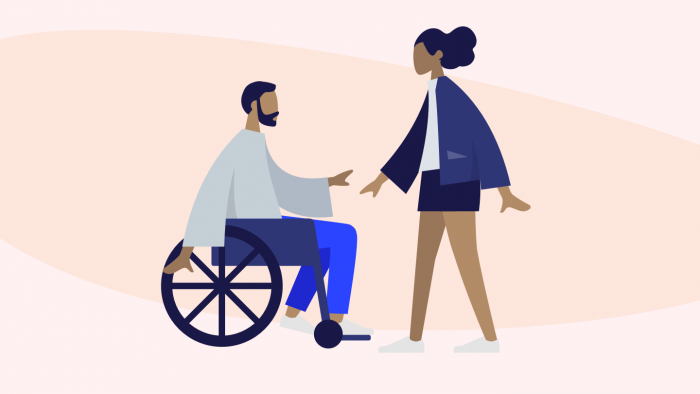See the full Design Indaba Festival programme
In 2015, I was diagnosed with a chronic illness that I thought I would heal from within a few months. Years passed and I did not heal. At points, I was unable to walk and needed a cane, yet I refused to consider myself disabled. I was embarrassed by the thought of it. However today, nearly four years later, I am proud to identify with such an amazing community.
Being a disabled designer has given me unique skills to see the built world in a different way, because it has not been designed for disabled people. To explore these perspectives, I joined the WITH Fellowship, a program that facilitates design with the disability community by partnering disabled creatives in top design studios.
During my fellowship at frog’s New York studio, I focused on bringing the disability design conversation into the workplace. The culmination of my fellowship was a panel discussion I moderated about designing with disability. Our panelists included Liz Jackson, disability advocate and founder of The Disabled List and the WITH Fellowship; Shannon Finnegan, artist and graphic designer whose work focuses heavily on disability; and Tucker Viemeister, esteemed Industrial Designer who created the inclusive OXO Good Grips and helped open frog’s New York studio. Here are some of the insights and learnings that came out of our discussion:
Talk About Language
When broaching the subject of disability, or any marginalized group, I have found there is often apprehension around what words to use because people are afraid to say the wrong thing. This is why we began the evening discussing language and terminology in hopes of eliminating these fears. Liz Jackson subscribes to the “#SayTheWord” campaign, which asserts that just by saying the word “disability,” you are destigmatizing it. Shannon Finnegan and I agreed that we prefer the term “disabled person,” but it is important to note that even within the community, feelings and preferences can widely differ. As designers strive to think more about engaging the disability community, it’s important to start with the simple question of language.
Perception is Important
As a disabled person, I think about how my community is perceived in society. I wonder if these limited perceptions have minimized our involvement in the design process. This prompted my question to our panelists on how the portrayal of disabled people, throughout history and in the media, have affected how we are perceived. “When I look in pop culture or the media, I don’t see anything that feels like my experience. We just don’t see the nuance of the lived experience of disability,” said Finnegan. In the media, disabled people are most often portrayed in two tropes: people to be inspired by and people to pity. These limiting tropes are usually portrayed by people who are visibly disabled, yet Jackson pointed out that most disabled people have an invisible disability, and these are the people not getting their needs met. I was happy that Jackson brought this up because as someone with an invisible disability, I am often misunderstood and forgotten about. This provides an important opportunity for designers to challenge their own perceptions and expand their definition of disability.
Go Beyond Empathy
Empathy is a buzzword in the design community, but is empathy really the answer for disability design? Both Jackson and Finnegan had some great insight into the nuance of “empathy” when it comes to design. Jackson posited that “empathetic designs are not intended for us, but rather to fix us. I don’t really know if that’s empathy.” Finnegan adds “people only want to empathize with a very specific part of my experience. They only want to empathize with the hard things.” Rather than designing with empathy, Jackson proposes a new design paradigm: designing with mutuality. She defines mutuality as “exist[ing] somewhere around the rejection of gratitude… where the recipient is viewed as a participant.” This creates a platform for successful co-creation between the designer and the user. It eliminates the notion that disabled people are meant to be grateful for what has been done for them, and allows them to be a part of the process.
Disability Design Panel from Shaina Garfield on Youtube.
Just Be Thoughtful
Even with all of the action towards inclusion, designers still ask, “If it’s not possible to get a disabled person in the room, how can one successfully design for them?” As a non-disabled person, Tucker Veimeister’s perspective was, “as you get older, everyone gets more disabled, you have to design for someone other than Superman.” This is a great and simple way to think outside of our internal biases in the often chaotic design process. Finnegan also brought up that while there are resources like ADA compliance that can help designers and business cover their bases, “there is a cultural component you won’t get unless you talk to a disabled person.” However, she also adds that “it’s not enough to meet one disabled person and think you understand the entire community.” Jackson summed up that at the end of the day, it was most important for people to “just be thoughtful.”
As we discovered from our evening of lively discussion and debate, disabled people are hungry to be a part of the process in the creation of their world. We want to be seen as equal participants, rather than pitied recipients. As designers, let us strive to provide these platforms for disabled people. While we are designing, we must pause and remember to challenge our biases. We must start thinking about disability from the inception of a project, rather than just a checklist at the end. These tenants will provide designers with an incredible opportunity to make a positive impact on society, no matter what they are designing.
Shaina is a disabled designer, who has been given unique perspectives and passion to make the world more inclusive and empathetic. She has a background in Industrial Design and Sustainability studies. Shaina is now at frog, completing a WITH fellowship where she is facilitating the disability design conversation.
This story first appeared on Medium. Garfield was one of 20 graduates to speak at antenna, a conference of global graduates curated by Design Indaba and co-produced by Dutch Design Week. Watch her full talk.
Read more:
The Parkinson Smart Cane is a portable device to assist Parkinson’s disease patients
These graduates want to change the world in ways we never thought possible









